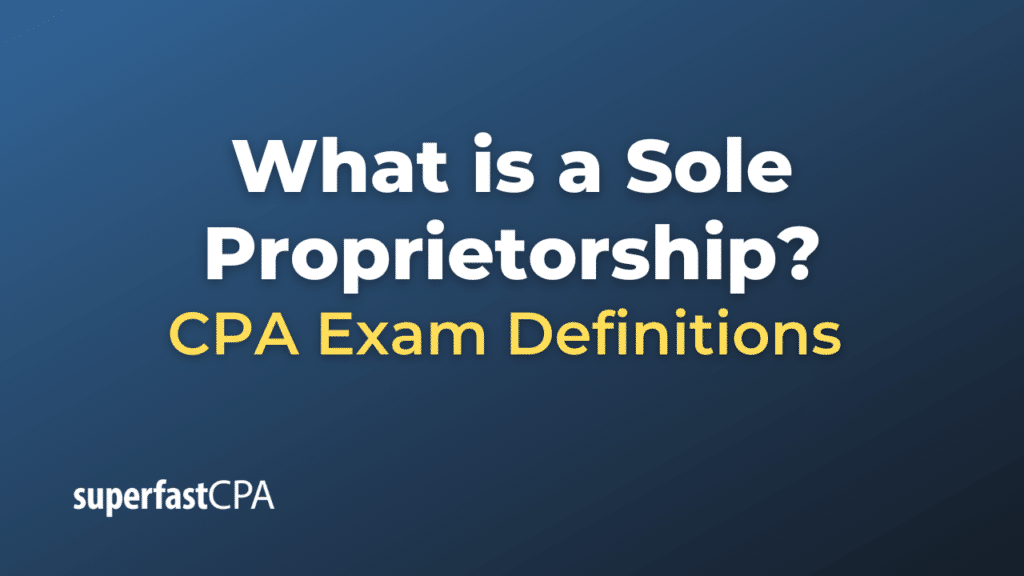Sole Proprietorship
A sole proprietorship is one of the simplest and most common forms of business organization. It refers to a business owned and operated by a single individual, who is responsible for all aspects of the business, including its debts and liabilities. The owner and the business are considered a single entity for legal and tax purposes.
Key characteristics of a sole proprietorship include:
- Single Ownership: The business is owned and operated by one person.
- Liability: The owner has unlimited personal liability for the business’s debts and obligations. This means that if the business incurs debts or is sued, the owner’s personal assets could be used to satisfy those obligations.
- Taxation: Income and expenses from the business are reported on the owner’s personal tax return. The business itself is not taxed separately. Profits earned by the business are considered personal income for the owner and are taxed accordingly.
- Simplicity: Establishing a sole proprietorship is generally straightforward and requires fewer formalities than other business structures like corporations or partnerships. In many jurisdictions, starting a sole proprietorship can be as simple as just beginning to conduct business, though specific licenses or permits may be required depending on the nature of the business.
- Control: The sole proprietor has full control over the business operations and makes all decisions related to the business.
- Lack of Continuity: The sole proprietorship does not have a separate existence apart from its owner. Therefore, the business typically ceases to exist upon the death or incapacitation of the owner, unless provisions are made for its continuation.
- No Separate Legal Entity: Unlike corporations, a sole proprietorship is not a separate legal entity from its owner. This means the owner has direct control over the business, but it also means they have direct liability.
Example of a Sole Proprietorship
Let’s delve into a detailed example of a sole proprietorship:
Scenario: Mike’s Coffee Corner
Background: Mike is passionate about coffee and has always dreamt of opening his own coffee shop. After saving money for a few years, he decides to take the plunge and starts a small coffee shop in his town named “Mike’s Coffee Corner.”
Establishing Mike’s Coffee Corner:
- Initial Setup: Mike finds a strategic corner location in his town with a lot of foot traffic. He rents the place and sets it up with cozy seating, brewing equipment, and decor that gives it a warm and welcoming ambiance.
- Licensing: To legally operate his coffee shop, Mike obtains the necessary permits and licenses from the local municipality. He also registers his business name, “Mike’s Coffee Corner,” with the appropriate local authorities.
- Operations: Mike is the sole owner and operator. He starts his day early, brewing coffee, preparing pastries, and serving customers. He also manages the finances, marketing, and other administrative aspects of the business.
- Earnings and Expenses: All earnings from the coffee shop go directly to Mike after deducting business expenses. At the end of the year, Mike reports the coffee shop’s earnings and expenses on his personal tax return.
- Liabilities: A few months into operation, a customer slips on a wet floor in the shop and gets injured. The customer decides to sue “Mike’s Coffee Corner” for damages. Since Mike operates as a sole proprietorship, he is personally liable for any legal claims against his business. This means that Mike’s personal assets, like his car or savings, could potentially be used to settle the claim.
- Benefits: On the positive side, Mike loves the freedom and control he has over his business. He enjoys building relationships with regular customers and takes pride in making business decisions without having to consult with partners or a board.
This example showcases the journey of a sole proprietor in the coffee shop industry. While Mike enjoys the direct control and simplicity of a sole proprietorship, he also faces the inherent risks and challenges, like personal liability, associated with this business structure.













